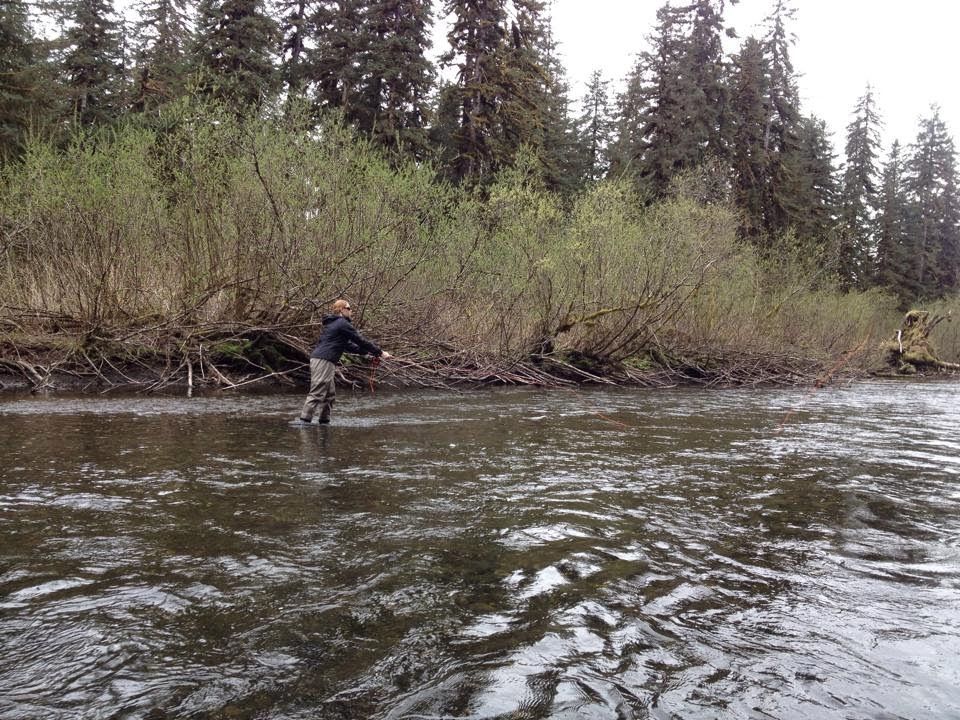My first week here 8 people from the University of Alaska (Juneau)
stayed with me in the bunkhouse. They were working in Yakutat High
School for a few days
doing some survival and outdoor skills with the kids, and during every
other waking hour they were out fishing. 6 are male students, 1 is a
man who is a professor at the school, and there was 1 girl about my age
who toughed out a week with the boys! She knows her stuff about fly
fishing- learned from a young age with her brother and father, currently
works at a fly shop in Juneau, and holds a great respect for the fish-
much like our family was taught to do. She doesn't worry about the
number of fish you catch, or taking them home, or holding them up as a
display of dominance. We discussed how fishing shouldn't be about
competing with other people and trying to prove yourself to others (as
many of the boys in her group do). There are true ethics behind fishing
that I guess not everyone was taught or cares enough about. Having an
understanding of the fish- whether it's scientific or almost a spiritual
connection- is what makes fishing so satisfying (although on occasion a good dinner also makes it quite
worth it! But not with steelhead, as it is an entirely catch and release fishery).
I think I am
understanding more and more why Grandpa fished, and how to him, fishing was so
much more than
just fishing. It certainly is for me. Just being
in the presence of these strong, vibrant, beautiful fish is humbling- contemplating
their precarious, long journeys between river and sea, up waterfalls, dodging
around fishermen's hooks and bear claws and simply even trying to gain a
sense of the lives of these amazing creatures; -if only we could hear
their stories! It is not so much about the waiting versus the catching but
about the patience, respect, and knowledge that is gained in the process
of fishing and through learning how to fish.
 |
| Relearning how to cast a fly rod- been a while! |
I get worried
that everything that Grandpa knew about fishing- and the fish- will be
lost with him. I know we have his fish journals, and I know we have his
stories, and I know the importance of what our family has learned and
what we have documented, as in my cousin Anna's manuscript. But how I wish I
had been old enough, mature enough, and interested enough to truly
learn what I could have from him. However, in a way, I do feel like
this is what he would've wanted- my
own quest to take on and learn
myself, having the rivers as well as his teachings to guide me. I think
that,
after all, is probably the best way to learn. A foundation of love of
the fish is what he left for me, for us; and it is up to each of us to decide
whether and how we will use it, what we will learn from it, and where it
will take us.
To be able to catch wild steelhead- when
populations everywhere else are plummeting, or even just see pods and
pods of them stagnant or darting beneath the surface, is something few
are fortunate enough to experience, and I cherish every moment of it.
 |
| In my new waders! |
One
thing I do know is that Grandpa would be proud that his granddaughter
finally wears waders! Thank you, USFS! Plenty of work I do
this summer will require them, and I've already used them a number of
times.
 |
| With my black rockfish |
My first time fishing out here
(which was also my first time ocean fishing!), Nate brought me out on
his skiff and we trolled two poles. I reeled in a black
rockfish, and later that evening he caught a decent sized King Salmon.
What a magnificent fish; I can't help but think that phrase every time I see any fish here, and I find myself saying it often! I
still have so many mixed feelings regarding catching these glorious,
huge creatures, even if we are eating them and they do not go to waste,
but my dissonance there is too complex for me to even sort out enough to write about.
 |
| Nate with a King Salmon |
Nate
also took me out on the Situk to do some fly fishing (we hiked a ways in from the road in our waders, which got warm!) and try to
get some underwater photos of spawning steelhead for some "Don't Tread
on Redd" conservation posters with his sweeeeet heavy underwater camera. Yakutat, as I'm sure is true of coastal Alaska in general, provides one with much to learn about fisheries management that doesn't involve
school; I am reluctant to think heading back in to the classroom for
graduate school is where I will learn the most!
I am doing my best to take in as much as I can about the management and conservation of these fisheries while I am here, gaining knowledge from sources and people who have been studying and working towards conserving these fish for years. It's weird how we develop certain interests and passions that energize us for some reason, while other people are driven by entirely different desires. I'm not really sure that I can say I am drawn to this work because of Grandpa and my family's fishing history, because I feel I was too young to understand much of it or be influenced this greatly by it. But it must come from somewhere! For whatever reason that I do it, I do it in Grandpa's words: For the Sake of the Fish.























